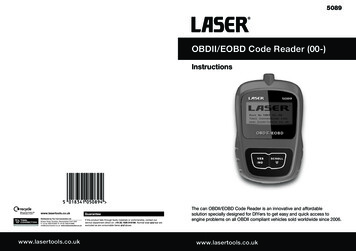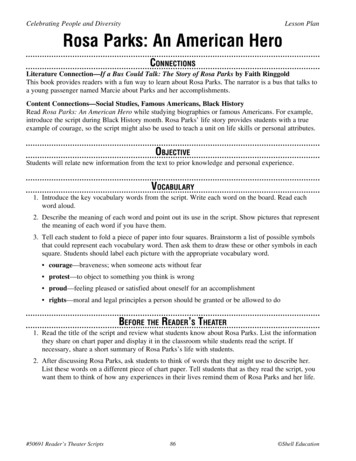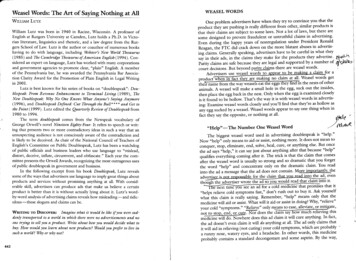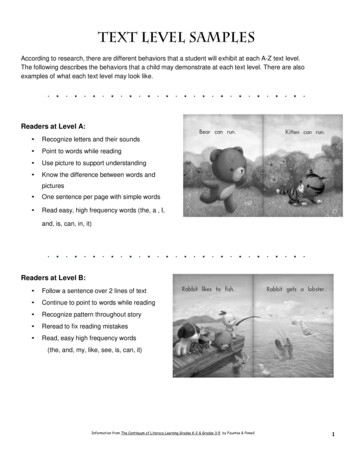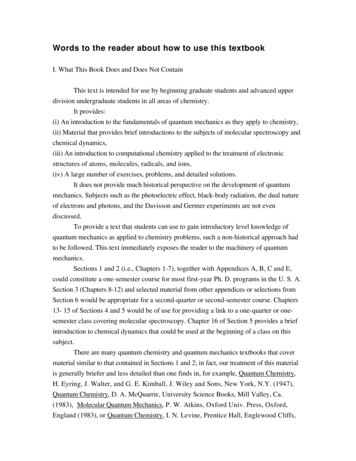
Transcription
Words to the reader about how to use this textbookI. What This Book Does and Does Not ContainThis text is intended for use by beginning graduate students and advanced upperdivision undergraduate students in all areas of chemistry.It provides:(i) An introduction to the fundamentals of quantum mechanics as they apply to chemistry,(ii) Material that provides brief introductions to the subjects of molecular spectroscopy andchemical dynamics,(iii) An introduction to computational chemistry applied to the treatment of electronicstructures of atoms, molecules, radicals, and ions,(iv) A large number of exercises, problems, and detailed solutions.It does not provide much historical perspective on the development of quantummechanics. Subjects such as the photoelectric effect, black-body radiation, the dual natureof electrons and photons, and the Davisson and Germer experiments are not evendiscussed.To provide a text that students can use to gain introductory level knowledge ofquantum mechanics as applied to chemistry problems, such a non-historical approach hadto be followed. This text immediately exposes the reader to the machinery of quantummechanics.Sections 1 and 2 (i.e., Chapters 1-7), together with Appendices A, B, C and E,could constitute a one-semester course for most first-year Ph. D. programs in the U. S. A.Section 3 (Chapters 8-12) and selected material from other appendices or selections fromSection 6 would be appropriate for a second-quarter or second-semester course. Chapters13- 15 of Sections 4 and 5 would be of use for providing a link to a one-quarter or onesemester class covering molecular spectroscopy. Chapter 16 of Section 5 provides a briefintroduction to chemical dynamics that could be used at the beginning of a class on thissubject.There are many quantum chemistry and quantum mechanics textbooks that covermaterial similar to that contained in Sections 1 and 2; in fact, our treatment of this materialis generally briefer and less detailed than one finds in, for example, Quantum Chemistry,H. Eyring, J. Walter, and G. E. Kimball, J. Wiley and Sons, New York, N.Y. (1947),Quantum Chemistry, D. A. McQuarrie, University Science Books, Mill Valley, Ca.(1983), Molecular Quantum Mechanics, P. W. Atkins, Oxford Univ. Press, Oxford,England (1983), or Quantum Chemistry, I. N. Levine, Prentice Hall, Englewood Cliffs,
N. J. (1991), Depending on the backgrounds of the students, our coverage may have to besupplemented in these first two Sections.By covering this introductory material in less detail, we are able, within theconfines of a text that can be used for a one-year or a two-quarter course, to introduce thestudent to the more modern subjects treated in Sections 3, 5, and 6. Our coverage ofmodern quantum chemistry methodology is not as detailed as that found in ModernQuantum Chemistry, A. Szabo and N. S. Ostlund, Mc Graw-Hill, New York (1989),which contains little or none of the introductory material of our Sections 1 and 2.By combining both introductory and modern up-to-date quantum chemistry materialin a single book designed to serve as a text for one-quarter, one-semester, two-quarter, orone-year classes for first-year graduate students, we offer a unique product.It is anticipated that a course dealing with atomic and molecular spectroscopy willfollow the student's mastery of the material covered in Sections 1- 4. For this reason,beyond these introductory sections, this text's emphasis is placed on electronic structureapplications rather than on vibrational and rotational energy levels, which are traditionallycovered in considerable detail in spectroscopy courses.In brief summary, this book includes the following material:1. The Section entitled The Basic Tools of Quantum Mechanics treatsthe fundamental postulates of quantum mechanics and several applications to exactlysoluble model problems. These problems include the conventional particle-in-a-box (in oneand more dimensions), rigid-rotor, harmonic oscillator, and one-electron hydrogenicatomic orbitals. The concept of the Born-Oppenheimer separation of electronic andvibration-rotation motions is introduced here. Moreover, the vibrational and rotationalenergies, states, and wavefunctions of diatomic, linear polyatomic and non-linearpolyatomic molecules are discussed here at an introductory level. This section alsointroduces the variational method and perturbation theory as tools that are used to deal withproblems that can not be solved exactly.2. The Section Simple Molecular Orbital Theory deals with atomic andmolecular orbitals in a qualitative manner, including their symmetries, shapes, sizes, andenergies. It introduces bonding, non-bonding, and antibonding orbitals, delocalized,hybrid, and Rydberg orbitals, and introduces Hückel-level models for the calculation ofmolecular orbitals as linear combinations of atomic orbitals (a more extensive treatment of
several semi-empirical methods is provided in Appendix F). This section also developsthe Orbital Correlation Diagram concept that plays a central role in using WoodwardHoffmann rules to predict whether chemical reactions encounter symmetry-imposedbarriers.3. The Electronic Configurations, Term Symbols, and StatesSection treats the spatial, angular momentum, and spin symmetries of the many-electronwavefunctions that are formed as antisymmetrized products of atomic or molecular orbitals.Proper coupling of angular momenta (orbital and spin) is covered here, and atomic andmolecular term symbols are treated. The need to include Configuration Interaction toachieve qualitatively correct descriptions of certain species' electronic structures is treatedhere. The role of the resultant Configuration Correlation Diagrams in the WoodwardHoffmann theory of chemical reactivity is also developed.4. The Section on Molecular Rotation and Vibration provides anintroduction to how vibrational and rotational energy levels and wavefunctions areexpressed for diatomic, linear polyatomic, and non-linear polyatomic molecules whoseelectronic energies are described by a single potential energy surface. Rotations of "rigid"molecules and harmonic vibrations of uncoupled normal modes constitute the starting pointof such treatments.5. The Time Dependent Processes Section uses time-dependent perturbationtheory, combined with the classical electric and magnetic fields that arise due to theinteraction of photons with the nuclei and electrons of a molecule, to derive expressions forthe rates of transitions among atomic or molecular electronic, vibrational, and rotationalstates induced by photon absorption or emission. Sources of line broadening and timecorrelation function treatments of absorption lineshapes are briefly introduced. Finally,transitions induced by collisions rather than by electromagnetic fields are briefly treated toprovide an introduction to the subject of theoretical chemical dynamics.6. The Section on More Quantitive Aspects of Electronic StructureCalculations introduces many of the computational chemistry methods that are usedto quantitatively evaluate molecular orbital and configuration mixing amplitudes. TheHartree-Fock self-consistent field (SCF), configuration interaction (CI),multiconfigurational SCF (MCSCF), many-body and Møller-Plesset perturbation theories,
coupled-cluster (CC), and density functional or Xα -like methods are included. Thestrengths and weaknesses of each of these techniques are discussed in some detail. Havingmastered this section, the reader should be familiar with how potential energyhypersurfaces, molecular properties, forces on the individual atomic centers, and responsesto externally applied fields or perturbations are evaluated on high speed computers.II. How to Use This Book: Other Sources of Information and Building NecessaryBackgroundIn most class room settings, the group of students learning quantum mechanics as itapplies to chemistry have quite diverse backgrounds. In particular, the level of preparationin mathematics is likely to vary considerably from student to student, as will the exposureto symmetry and group theory. This text is organized in a manner that allows students toskip material that is already familiar while providing access to most if not all necessarybackground material. This is accomplished by dividing the material into sections, chaptersand Appendices which fill in the background, provide methodological tools, and provideadditional details.The Appendices covering Point Group Symmetry and Mathematics Review areespecially important to master. Neither of these two Appendices provides a first-principlestreatment of their subject matter. The students are assumed to have fulfilled normalAmerican Chemical Society mathematics requirements for a degree in chemistry, so only areview of the material especially relevant to quantum chemistry is given in the MathematicsReview Appendix.Likewise, the student is assumed to have learned or to besimultaneously learning about symmetry and group theory as applied to chemistry, so thissubject is treated in a review and practical-application manner here. If group theory is to beincluded as an integral part of the class, then this text should be supplemented (e.g., byusing the text Chemical Applications of Group Theory, F. A. Cotton, Interscience, NewYork, N. Y. (1963)).The progression of sections leads the reader from the principles of quantummechanics and several model problems which illustrate these principles and relate tochemical phenomena, through atomic and molecular orbitals, N-electron configurations,states, and term symbols, vibrational and rotational energy levels, photon-inducedtransitions among various levels, and eventually to computational techniques for treatingchemical bonding and reactivity.
At the end of each Section, a set of Review Exercises and fully worked outanswers are given. Attempting to work these exercises should allow the student todetermine whether he or she needs to pursue additional background building via theAppendices .In addition to the Review Exercises , sets of Exercises and Problems, andtheir solutions, are given at the end of each section.The exercises are brief and highly focused on learning a particular skill. They allow thestudent to practice the mathematical steps and other material introduced in the section. Theproblems are more extensive and require that numerous steps be executed. They illustrateapplication of the material contained in the chapter to chemical phenomena and they helpteach the relevance of this material to experimental chemistry. In many cases, new materialis introduced in the problems, so all readers are encouraged to become actively involved insolving all problems.To further assist the learning process, readers may find it useful to consult othertextbooks or literature references. Several particular texts are recommended for additionalreading, further details, or simply an alternative point of view. They include the following(in each case, the abbreviated name used in this text is given following the properreference):1. Quantum Chemistry, H. Eyring, J. Walter, and G. E. Kimball, J. Wileyand Sons, New York, N.Y. (1947)- EWK.2. Quantum Chemistry, D. A. McQuarrie, University Science Books, Mill Valley, Ca.(1983)- McQuarrie.3. Molecular Quantum Mechanics, P. W. Atkins, Oxford Univ. Press, Oxford, England(1983)- Atkins.4. The Fundamental Principles of Quantum Mechanics, E. C. Kemble, McGraw-Hill, NewYork, N.Y. (1937)- Kemble.5. The Theory of Atomic Spectra, E. U. Condon and G. H. Shortley, Cambridge Univ.Press, Cambridge, England (1963)- Condon and Shortley.6. The Principles of Quantum Mechanics, P. A. M. Dirac, Oxford Univ. Press, Oxford,England (1947)- Dirac.7. Molecular Vibrations, E. B. Wilson, J. C. Decius, and P. C. Cross, Dover Pub., NewYork, N. Y. (1955)- WDC.8. Chemical Applications of Group Theory, F. A. Cotton, Interscience, New York, N. Y.(1963)- Cotton.9. Angular Momentum, R. N. Zare, John Wiley and Sons, New York, N. Y. (1988)Zare.
10. Introduction to Quantum Mechanics, L. Pauling and E. B. Wilson, Dover Publications,Inc., New York, N. Y. (1963)- Pauling and Wilson.11. Modern Quantum Chemistry, A. Szabo and N. S. Ostlund, Mc Graw-Hill, New York(1989)- Szabo and Ostlund.12. Quantum Chemistry, I. N. Levine, Prentice Hall, Englewood Cliffs, N. J. (1991)Levine.13. Energetic Principles of Chemical Reactions, J. Simons, Jones and Bartlett, PortolaValley, Calif. (1983),
Section 1 The Basic Tools of Quantum MechanicsChapter 1Quantum Mechanics Describes Matter in Terms of Wavefunctions and Energy Levels.Physical Measurements are Described in Terms of Operators Acting on WavefunctionsI. Operators, Wavefunctions, and the Schrödinger EquationThe trends in chemical and physical properties of the elements described beautifullyin the periodic table and the ability of early spectroscopists to fit atomic line spectra bysimple mathematical formulas and to interpret atomic electronic states in terms of empiricalquantum numbers provide compelling evidence that some relatively simple frameworkmust exist for understanding the electronic structures of all atoms. The great predictivepower of the concept of atomic valence further suggests that molecular electronic structureshould be understandable in terms of those of the constituent atoms.Much of quantum chemistry attempts to make more quantitative these aspects ofchemists' view of the periodic table and of atomic valence and structure. By starting from'first principles' and treating atomic and molecular states as solutions of a so-calledSchrödinger equation, quantum chemistry seeks to determine what underlies the empiricalquantum numbers, orbitals, the aufbau principle and the concept of valence used byspectroscopists and chemists, in some cases, even prior to the advent of quantummechanics.Quantum mechanics is cast in a language that is not familiar to most students ofchemistry who are examining the subject for the first time. Its mathematical content andhow it relates to experimental measurements both require a great deal of effort to master.With these thoughts in mind, the authors have organized this introductory section in amanner that first provides the student with a brief introduction to the two primaryconstructs of quantum mechanics, operators and wavefunctions that obey a Schrödingerequation, then demonstrates the application of these constructs to several chemicallyrelevant model problems, and finally returns to examine in more detail the conceptualstructure of quantum mechanics.By learning the solutions of the Schrödinger equation for a few model systems, thestudent can better appreciate the treatment of the fundamental postulates of quantummechanics as well as their relation to experimental measurement because the wavefunctionsof the known model problems can be used to illustrate.
A. OperatorsEach physically measurable quantity has a corresponding operator. The eigenvaluesof the operator tell the values of the corresponding physical property that can be observedIn quantum mechanics, any experimentally measurable physical quantity F (e.g.,energy, dipole moment, orbital angular momentum, spin angular momentum, linearmomentum, kinetic energy) whose classical mechanical expression can be written in termsof the cartesian positions {qi} and momenta {pi} of the particles that comprise the systemof interest is assigned a corresponding quantum mechanical operator F. Given F in termsof the {qi} and {pi}, F is formed by replacing pj by -ih / qj and leaving qj untouched.For example, ifF Σ l 1,N (pl2/2ml 1/2 k(ql-ql0)2 L(ql-ql0)),thenF Σ l 1,N (- h2/2ml 2/ ql2 1/2 k(ql-ql0)2 L(ql-ql0))is the corresponding quantum mechanical operator. Such an operator would occur when,for example, one describes the sum of the kinetic energies of a collection of particles (theΣ l 1,N (pl2/2ml ) term, plus the sum of "Hookes' Law" parabolic potentials (the 1/2 Σ l 1,Nk(ql-ql0)2), and (the last term in F) the interactions of the particles with an externallyapplied field whose potential energy varies linearly as the particles move away from theirequilibrium positions {ql0}.The sum of the z-components of angular momenta of a collection of N particles hasF Σ j 1,N (xjpyj - yjpxj),and the corresponding operator isF -ih Σ j 1,N (xj / yj - yj / xj).The x-component of the dipole moment for a collection of N particles
hasF Σ j 1,N Zjexj, andF Σ j 1,N Zjexj ,where Zje is the charge on the jth particle.The mapping from F to F is straightforward only in terms of cartesian coordinates.To map a classical function F, given in terms of curvilinear coordinates (even if they areorthogonal), into its quantum operator is not at all straightforward. Interested readers arereferred to Kemble's text on quantum mechanics which deals with this matter in detail. Themapping can always be done in terms of cartesian coordinates after which a transformationof the resulting coordinates and differential operators to a curvilinear system can beperformed. The corresponding transformation of the kinetic energy operator to sphericalcoordinates is treated in detail in Appendix A. The text by EWK also covers this topic inconsiderable detail.The relationship of these quantum mechanical operators to experimentalmeasurement will be made clear later in this chapter. For now, suffice it to say that theseoperators define equations whose solutions determine the values of the correspondingphysical property that can be observed when a measurement is carried out; only the valuesso determined can be observed. This should suggest the origins of quantum mechanics'prediction that some measurements will produce discrete or quantized values of certainvariables (e.g., energy, angular momentum, etc.).B. WavefunctionsThe eigenfunctions of a quantum mechanical operator depend on the coordinatesupon which the operator acts; these functions are called wavefunctionsIn addition to operators corresponding to each physically measurable quantity,quantum mechanics describes the state of the system in terms of a wavefunction Ψ that is afunction of the coordinates {qj} and of time t. The function Ψ(qj,t) 2 Ψ*Ψ gives theprobability density for observing the coordinates at the values qj at time t. For a manyparticle system such as the H2O molecule, the wavefunction depends on many coordinates.For the H2O example, it depends on the x, y, and z (or r,θ, and φ) coordinates of the ten
electrons and the x, y, and z (or r,θ, and φ) coordinates of the oxygen nucleus and of thetwo protons; a total of thirty-nine coordinates appear in Ψ.In classical mechanics, the coordinates qj and their corresponding momenta pj arefunctions of time. The state of the system is then described by specifying qj(t) and pj(t). Inquantum mechanics, the concept that qj is known as a function of time is replaced by theconcept of the probability density for finding qj at a particular value at a particular time t: Ψ(qj,t) 2. Knowledge of the corresponding momenta as functions of time is alsorelinquished in quantum mechanics; again, only knowledge of the probability density forfinding pj with any particular value at a particular time t remains.C. The Schrödinger EquationThis equation is an eigenvalue equation for the energy or Hamiltonian operator; itseigenvalues provide the energy levels of the system1. The Time-Dependent EquationIf the Hamiltonian operator contains the time variable explicitly, one must solve thetime-dependent Schrödinger equationHow to extract from Ψ(qj,t) knowledge about momenta is treated below in Sec. III.A, where the structure of quantum mechanics, the use of operators and wavefunctions tomake predictions and interpretations about experimental measurements, and the origin of'uncertainty relations' such as the well known Heisenberg uncertainty condition dealingwith measurements of coordinates and momenta are also treated.Before moving deeper into understanding what quantum mechanics 'means', it isuseful to learn how the wavefunctions Ψ are found by applying the basic equation ofquantum mechanics, the Schrödinger equation, to a few exactly soluble model problems.Knowing the solutions to these 'easy' yet chemically very relevant models will thenfacilitate learning more of the details about the structure of quantum mechanics becausethese model cases can be used as 'concrete examples'.The Schrödinger equation is a differential equation depending on time and on all ofthe spatial coordinates necessary to describe the system at hand (thirty-nine for the H2Oexample cited above). It is usually writtenH Ψ i h Ψ/ t
where Ψ(qj,t) is the unknown wavefunction and H is the operator corresponding to thetotal energy physical property of the system. This operator is called the Hamiltonian and isformed, as stated above, by first writing down the classical mechanical expression for thetotal energy (kinetic plus potential) in cartesian coordinates and momenta and then replacingall classical momenta pj by their quantum mechanical operators pj - ih / qj .For the H2O example used above, the classical mechanical energy of all thirteenparticles isE Σ i { pi2/2me 1/2 Σ j e2/ri,j - Σ a Zae2/ri,a } Σ a {pa2/2ma 1/2 Σ b ZaZbe2/ra,b },where the indices i and j are used to label the ten electrons whose thirty cartesiancoordinates are {qi} and a and b label the three nuclei whose charges are denoted {Za}, andwhose nine cartesian coordinates are {qa}. The electron and nuclear masses are denoted meand {ma}, respectively.The corresponding Hamiltonian operator isH Σ i { - (h2/2me) 2/ qi2 1/2 Σ j e2/ri,j - Σ a Zae2/ri,a } Σ a { - (h2/2ma) 2/ qa2 1/2 Σ b ZaZbe2/ra,b }.Notice that H is a second order differential operator in the space of the thirty-nine cartesiancoordinates that describe the positions of the ten electrons and three nuclei. It is a secondorder operator because the momenta appear in the kinetic energy as pj2 and pa2, and thequantum mechanical operator for each momentum p -ih / q is of first order.The Schrödinger equation for the H2O example at hand then readsΣ i { - (h2/2me) 2/ qi2 1/2 Σ j e2/ri,j - Σ a Zae2/ri,a } Ψ Σ a { - (h2/2ma) 2/ qa2 1/2 Σ b ZaZbe2/ra,b } Ψ i h Ψ/ t.2. The Time-Independent Equation
If the Hamiltonian operator does not contain the time variable explicitly, one cansolve the time-independent Schrödinger equationIn cases where the classical energy, and hence the quantum Hamiltonian, do notcontain terms that are explicitly time dependent (e.g., interactions with time varyingexternal electric or magnetic fields would add to the above classical energy expression timedependent terms discussed later in this text), the separations of variables techniques can beused to reduce the Schrödinger equation to a time-independent equation.In such cases, H is not explicitly time dependent, so one can assume that Ψ(qj,t) isof the formΨ(qj,t) Ψ(qj) F(t).Substituting this 'ansatz' into the time-dependent Schrödinger equation givesΨ(qj) i h F/ t H Ψ(qj) F(t) .Dividing by Ψ(qj) F(t) then givesF-1 (i h F/ t) Ψ -1 (H Ψ(qj) ).Since F(t) is only a function of time t, and Ψ(qj) is only a function of the spatialcoordinates {qj}, and because the left hand and right hand sides must be equal for allvalues of t and of {qj}, both the left and right hand sides must equal a constant. If thisconstant is called E, the two equations that are embodied in this separated Schrödingerequation read as follows:H Ψ(qj) E Ψ(qj),i h F(t)/ t ih dF(t)/dt E F(t).The first of these equations is called the time-independent Schrödinger equation; itis a so-called eigenvalue equation in which one is asked to find functions that yield aconstant multiple of themselves when acted on by the Hamiltonian operator. Such functionsare called eigenfunctions of H and the corresponding constants are called eigenvalues of H.
For example, if H were of the form - h2/2M 2/ φ2 H , then functions of the form exp(imφ) would be eigenfunctions because{ - h2/2M 2/ φ2} exp(i mφ) { m2 h2 /2M } exp(i mφ).In this case, { m2 h2 /2M } is the eigenvalue.When the Schrödinger equation can be separated to generate a time-independentequation describing the spatial coordinate dependence of the wavefunction, the eigenvalueE must be returned to the equation determining F(t) to find the time dependent part of thewavefunction. By solvingih dF(t)/dt E F(t)once E is known, one obtainsF(t) exp( -i Et/ h),and the full wavefunction can be written asΨ(qj,t) Ψ(qj) exp (-i Et/ h).For the above example, the time dependence is expressed byF(t) exp ( -i t { m2 h2 /2M }/ h).Having been introduced to the concepts of operators, wavefunctions, theHamiltonian and its Schrödinger equation, it is important to now consider several examplesof the applications of these concepts. The examples treated below were chosen to providethe learner with valuable experience in solving the Schrödinger equation; they were alsochosen because the models they embody form the most elementary chemical models ofelectronic motions in conjugated molecules and in atoms, rotations of linear molecules, andvibrations of chemical bonds.II. Examples of Solving the Schrödinger EquationA. Free-Particle Motion in Two Dimensions
The number of dimensions depends on the number of particles and the number ofspatial (and other) dimensions needed to characterize the position and motion of eachparticle1. The Schrödinger EquationConsider an electron of mass m and charge e moving on a two-dimensional surfacethat defines the x,y plane (perhaps the electron is constrained to the surface of a solid by apotential that binds it tightly to a narrow region in the z-direction), and assume that theelectron experiences a constant potential V0 at all points in this plane (on any real atomic ormolecular surface, the electron would experience a potential that varies with position in amanner that reflects the periodic structure of the surface). The pertinent time independentSchrödinger equation is:- h2/2m ( 2/ x2 2/ y2)ψ(x,y) V 0ψ(x,y) E ψ(x,y).Because there are no terms in this equation that couple motion in the x and y directions(e.g., no terms of the form xayb or / x / y or x / y), separation of variables can be usedto write ψ as a product ψ(x,y) A(x)B(y). Substitution of this form into the Schrödingerequation, followed by collecting together all x-dependent and all y-dependent terms, gives;- h2/2m A-1 2A/ x2 - h2/2m B-1 2B/ y2 E-V0.Since the first term contains no y-dependence and the second contains no x-dependence,both must actually be constant (these two constants are denoted Ex and Ey, respectively),which allows two separate Schrödinger equations to be written:- h2/2m A-1 2A/ x2 Ex, and- h2/2m B-1 2B/ y2 Ey.The total energy E can then be expressed in terms of these separate energies Ex and Ey asEx Ey E-V0. Solutions to the x- and y- Schrödinger equations are easily seen to be:A(x) exp(ix(2mEx/h2)1/2) and exp(-ix(2mEx/h2)1/2) ,
B(y) exp(iy(2mEy/h2)1/2) and exp(-iy(2mEy/h2)1/2).Two independent solutions are obtained for each equation because the x- and y-spaceSchrödinger equations are both second order differential equations.2. Boundary ConditionsThe boundary conditions, not the Schrödinger equation, determine whether theeigenvalues will be discrete or continuousIf the electron is entirely unconstrained within the x,y plane, the energies Ex and Eycan assume any value; this means that the experimenter can 'inject' the electron onto the x,yplane with any total energy E and any components Ex and Ey along the two axes as long asEx Ey E. In such a situation, one speaks of the energies along both coordinates asbeing 'in the continuum' or 'not quantized'.In contrast, if the electron is constrained to remain within a fixed area in the x,yplane (e.g., a rectangular or circular region), then the situation is qualitatively different.Constraining the electron to any such specified area gives rise to so-called boundaryconditions that impose additional requirements on the above A and B functions.These constraints can arise, for example, if the potential V0(x,y) becomes very large forx,y values outside the region, in which case, the probability of finding the electron outsidethe region is very small. Such a case might represent, for example, a situation in which themolecular structure of the solid surface changes outside the enclosed region in a way that ishighly repulsive to the electron.For example, if motion is constrained to take place within a rectangular regiondefined by 0 x Lx; 0 y Ly, then the continuity property that all wavefunctions mustobey (because of their interpretation as probability densities, which must be continuous)causes A(x) to vanish at 0 and at Lx. Likewise, B(y) must vanish at 0 and at Ly. Toimplement these constraints for A(x), one must linearly combine the above two solutionsexp(ix(2mEx/h2)1/2) and exp(-ix(2mEx/h2)1/2) to achieve a function that vanishes at x 0:A(x) exp(ix(2mEx/h2)1/2) - exp(-ix(2mEx/h2)1/2).One is allowed to linearly combine solutions of the Schrödinger equation that have the sameenergy (i.e., are degenerate) because Schrödinger equations are linear differential
equations. An analogous process must be applied to B(y) to achieve a function thatvanishes at y 0:B(y) exp(iy(2mEy/h2)1/2) - exp(-iy(2mEy/h2)1/2).Further requiring A(x) and B(y) to vanish, respectively, at x Lx and y Ly, givesequations that can be obeyed only if Ex and Ey assume particular values:exp(iLx(2mEx/h2)1/2) - exp(-iLx(2mEx/h2)1/2) 0, andexp(iLy(2mEy/h2)1/2) - exp(-iLy(2mEy/h2)1/2) 0.These equations are equivalent tosin(Lx(2mEx/h2)1/2) sin(Ly(2mEy/h2)1/2) 0.Knowing that sin(θ) vanishes at θ nπ, for n 1,2,3,., (although the sin(nπ) functionvanishes for n 0, this function vanishes for all x or y, and is therefore unacceptablebecause it represents zero probability density at all points in space) one concludes that theenergies Ex and Ey
There are many quantum chemistry and quantum mechanics textbooks that cover material similar to that contained in Sections 1 and 2; in fact, our treatment of this material is generally briefer and less detailed than one finds in, for example, Quantum Chemistry , H. Eyring, J. Walter, and


